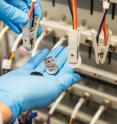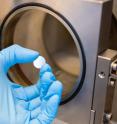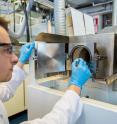Researchers developed manufacturing method for batteries with organic electrode materials
Related images
(click to enlarge)
With people wanting to use smaller electronic devices, smaller energy storage systems are needed. Researchers of Aalto University in Finland have demonstrated the fabrication of electrochemically active organic lithium electrode thin films, which help make microbatteries more efficient than before. Researchers used a combined atomic/molecular layer deposition (ALD/MLD) technique, to prepare lithium terephthalate, a recently found anode material for a lithium-ion battery. When microbatteries are manufatured, the key challenge is to make them able to store large amounts of energy in a small space. One way to improve the energy density is to manufacure the batteries based on three-dimensional microstructured architectures. This may increase the effective surface inside a battery- even dozens of times. However, the production of materials fit for these has proven to be very difficult.
- ALD is a great method for making battery materials fit for 3D microstructured architectures. Our method shows it is possible to even produce organic electrode materials by using ALD, which increases the opportunities to manufacture efficient microbatteries, says doctoral candidate Mikko Nisula from Aalto University.
The researchers' deposition process for Li-terephthalate is shown to comply well with the basic principles of ALD-type growth, including the sequential self-saturated surface reactions, which is a necessity when aiming at micro-lithium-ion devices with three-dimensional architectures. The as-deposited films are found to be crystalline across the deposition temperature range of 200?280 °C, which is a trait that is highly desired for an electrode material, but rather unusual for hybrid organic?inorganic thin films. An excellent rate capability is ascertained for the Li-terephthalate films, with no conductive additives required. The electrode performance can be further enhanced by depositing a thin protective LiPON solid-state electrolyte layer on top of Li-terephthalate. This yields highly stable structures with a capacity retention of over 97% after 200 charge/discharge cycles at 3.2 C.
The study about the method has now been published in the latest edition of Nano Letters.
Source: Aalto University
Articles on the same topic
- Argonne continues to pave way for improved battery performance testingThu, 31 Mar 2016, 19:26:09 UTC
- Molecular-scale ALD discovery could have industrial-sized impactThu, 31 Mar 2016, 0:54:40 UTC
Other sources
- Improving battery performance testingfrom Science DailyThu, 31 Mar 2016, 19:20:42 UTC
- Argonne Continues to Pave Way for Improved Battery Performance Testingfrom Newswise - ScinewsThu, 31 Mar 2016, 17:20:40 UTC
- Researchers continue to pave way for improved battery performance testingfrom PhysorgThu, 31 Mar 2016, 16:50:49 UTC
- Molecular-scale ALD discovery could have industrial-sized impactfrom Science DailyThu, 31 Mar 2016, 0:50:42 UTC
- Molecular-scale ALD discovery could have industrial-sized impactfrom PhysorgWed, 30 Mar 2016, 21:20:43 UTC
- Researchers developed manufacturing method for batteries with organic electrode materialsfrom Science DailyTue, 29 Mar 2016, 14:50:38 UTC
- Researchers developed manufacturing method for batteries with organic electrode materialsfrom PhysorgTue, 29 Mar 2016, 7:02:01 UTC


